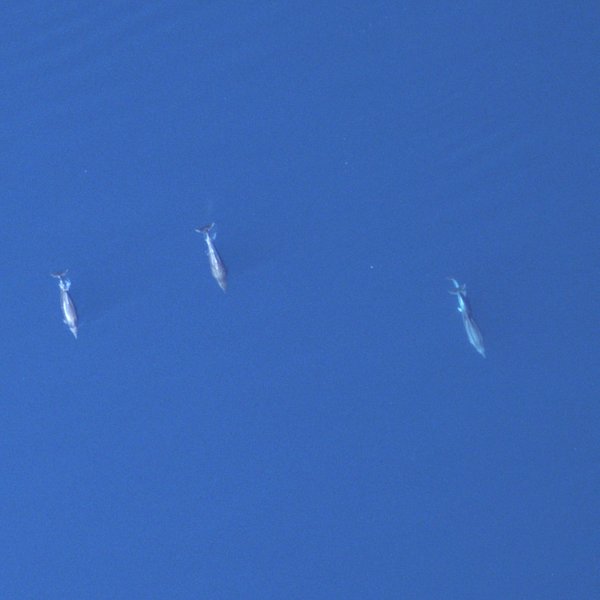Digital aerial surveying of marine birds and mammals – HiDef
Since 2014, we carry out aerial marine bird and mammal surveys using the high-resolution HiDef video system.
HiDef aerial surveys for environmental studies, monitoring and research
Aerial surveys using digital videos are suitable for all large-scale surveys of birds, marine mammals and other marine megafauna such as sharks and turtles in coastal and offshore waters. SH has already carried out resting bird counts on inaccessible outer shoals.
The method is used in environmental studies as part of offshore projects such as offshore wind farms and serves as a basis for expert reports and environmental impact studies. BioConsult SH also carries out digital aerial surveys for other monitoring and research projects in the high seas.

© BioConsult SH
White beaked dolphins (Lagenorhynchus albirostris) captured with our high resolution HiDef cameras.
Disturbance-free and accurate data collection
The HiDef-system consists of four high-resolution video cameras, recording the sea surface at a resolution of 2 cm/pixel across a transect of 544 m width from an altitude of approx. 500 m.
Due to this in contrast to previously used observer flights higher altitude, offshore wind farm areas can be flown over safely and thus still be surveyed. Disturbances are avoided. Even species that are especially sensitive to disturbance, such as common scoters, do not fly up during digital aerial counts.
This is a major advantage over observer flights, not just for surveys in sensitive protected areas. Low-impact surveying also leads to more reliable results, as the behaviour and distribution patterns of the birds are unaffected by the counting method.
The very high resolution of the images and the recording rate of approx. seven images per second means that an object is visible in at least five consecutive images. This enables our experienced team of image analysts, ornithologists and marine mammal experts to reliably detect the objects and to even identify species on species level that are difficult to distinguish.
The cameras are slightly tilted forwards or backwards and mounted in a rotating rig to keep them turned away from the sun avoiding reflections and data loss.
This camera angle also improves the detection of submerged animals, which is particularly important for the detection of marine mammals.

© BioConsult SH
Left: Arrangement of the HiDef video system with four individual cameras for standard transect detection. Right: Alignment of the HiDef video system tilted forwards or backwards by the angle α to avoid sun reflection on the image.
Excellent data quality and verifiable results
The data is analysed in two consecutive steps:
- object detection (finding and labelling the objects in the footage) and
- object identification
In the quality assurance process of both steps, 20 % of the video footage is subject to an independent review to meet our highest standards of data quality.
Permanent storage of the images allows clients and authorities to re-review all data at all times and thus ensures a legally secure basis for our expert reports.
The standard for surveys of resting birds and marine mammals in the high seas
The method has therefore been the standard for environmental studies for offshore wind projects and other marine infrastructure projects in Germany since 2014. It is increasingly becoming the preferred method in many national and international monitoring and research projects and is gradually replacing observer-based flights around the world.
In the meantime, we at BioConsult SH can look back on almost 1000 flights in ten European countries. Over the years, BioConsult SH has together with our partner companies HiDef Aerial Surveying and Biotope accumulated a unique and extensive database of video footage. This applies both to the number of marine areas covered as well as to the range of species recorded.
Looking ahead, BioConsult SH is working on the gradual automation of data analysis. Our data are an ideal basis for training artificial intelligence algorithms, which will also support the manual analysis of videos at BioConsult SH in the near future.
Reference projects
Publications
Comparison of digital video surveys with visual aerial surveys for bird monitoring at sea
J Ornithol (2019)


















